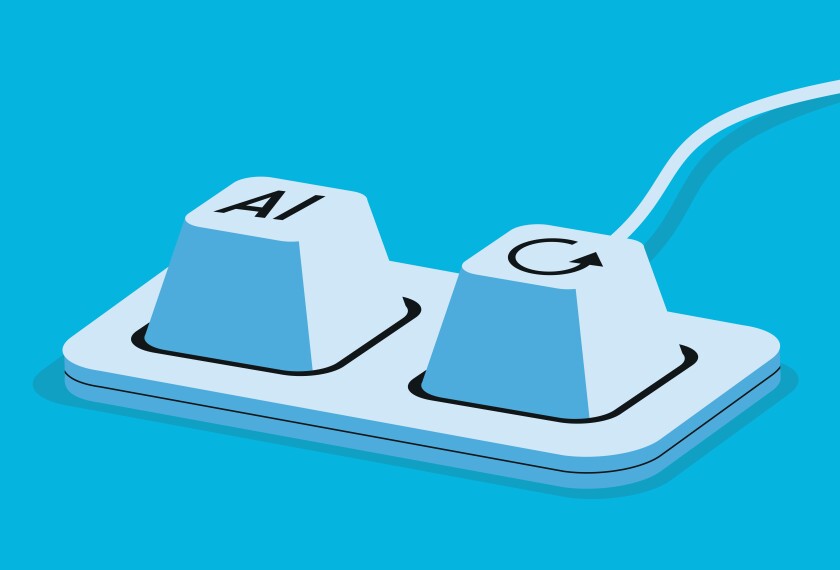Educators need to work with vendors and tech developers to ensure artificial intelligence-driven innovations for schools go hand-in-hand with managing the technology’s risks, recommends guidance released July 8 by the U.S. Department of Education.
The guidance—called “"—includes extensive recommendations for both vendors and school district officials.
In some ways, companies and tech developers are in a tough spot with AI. Many want to move cautiously in developing tools with educator feedback that are properly tested and don’t amplify societal bias or deliver inaccurate information.
On the other hand, developers also want to serve the current market—and don’t want to get left behind the competition. And they want to find new and exciting uses for AI.
It’s not an either-or, the department’s guidance argues. Vendors and educators can try new things with AI—like enabling teachers to use it for writing emails—if they consider important questions such as: Who will ensure that students’ private information isn’t shared? Or, as districts use AI-powered “early warning” systems that could identify students at-risk of dropping out, how is it possible to evaluate whether the system is instead magnifying biases or even violating students’ civil rights?
The guidance also recommends that AI should not be allowed to make decisions unchecked by educators, and that developers need to design AI tools based on evidence-based practices, incorporating educator input and feedback, while safeguarding students’ data and civil rights.
The document grew out of the Biden administration’s AI bill of rights, which was released in October of 2022, and its , which was put forth a year later and called on the Education Department to develop AI policy resources for school districts.
And it builds on the department’s own report on AI in K-12 schools, released in May 2023. That document helped form the basis of some states’ and school districts’ approach to AI policy.
The new guidance is not regulatory, meaning no developer or district is obligated to adhere to it. Instead, it is intended to shape educators’ and developers’ thinking.
One key point the department is making simply by releasing the guidance now: Developers and school districts don’t need sweeping, official federal action—like regulation or new legislation—to get started on creating responsible AI tools.
“We don’t have to wait,” said Jeremy Roschelle, the co-executive director of learning science research for Digital Promise, a nonprofit organization that works on equity and technology issues in schools. He was one of the experts who informed the guidance. “We have some solid principles already, and they can fly.”
For example, Roschelle said “if there is algorithmic discrimination in a product and it’s blocking students’ opportunity to learn or unfairly disciplining students … that can be a civil rights issue.”
Plus, he said “we have a ton of laws on privacy. They’re not perfect. They need an update. But we can get going. And we have a lot of evidence [on what works in education]. Those are three really strong stakes in the ground” to guide AI development.
Here are the five key recommendations in the report for vendors and educators :
1. Design with teaching and learning and mind
This encompasses steps such as ensuring that humans—namely, teachers—are the final decisionmakers on any AI recommendations, and that products are deployed ethically.
2. Show how evidence-backed principles were used to create products
Developers need to be clear about how they use evidence-backed principles to design their products, as well as which student outcomes their tools are meant to improve. They also need to help educators understand which types of students their tools are for and tested on, and under what conditions.
3. Take steps to remove or mitigate bias
AI can amplify societal biases—a dangerous risk when it’s being deployed for education. Developers need to ask themselves questions, the guidance notes, such as: “What steps can we take to audit and remove the potential bias or algorithmic discrimination in our product, with special attention to mitigating any impacts for vulnerable or underserved populations?”
4. Protect student privacy
For starters, developers need to know the major laws and regulations governing student privacy, including the Family Educational Rights and Privacy Act (FERPA) and the Children’s Online Privacy Protection Act (COPPA). To be sure, cybersecurity has been a major responsibility of districts—and vendors—for years. But AI privacy violations can go beyond the typical cybersecurity woes. For instance, students and even educators have used AI to create “deepfakes” of their classmates and colleagues. Developers need to probe questions, the guidance says, such as: “What are we hearing as top safety and security concerns from educators regarding our product or similar products?”
5. Be transparent about how products are designed
Developers need to be clear with educators about how their AI-powered products actually work. That could include steps such as providing demonstrations, training for educators on using the products, and guaranteeing that if something goes wrong, it will be fixed quickly.
The guidance recommends that developers ask themselves: “How can our organization contribute to AI literacy in the broader ed-tech ecosystem?”
The new guidance was crafted, in part, through an “extensive series” of public listening sessions with students, parents, and educators as well as developers, industry associations, and nonprofit organizations. Department officials also met with a smaller group of developers, drawn from the initial participants.






